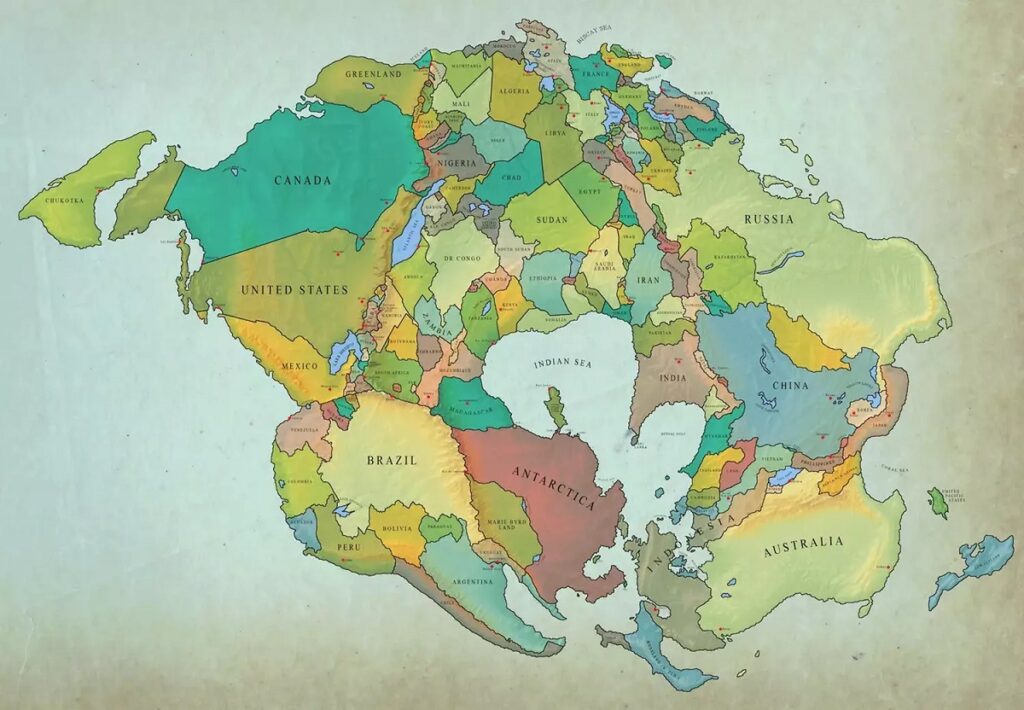If you believed shifting political boundaries were the only changes happening around us, think again. A newly revealed map projection is generating excitement among geologists, educators, and the naturally inquisitive. When we look at the Earth’s vast history, the borders we recognize today are merely fleeting outlines on a perpetually evolving canvas.
A Peek into Our Continents’ Remote Future
Imagine fast-forwarding 250 million years. Instead of navigating crowded customs lines, you could drive from South Africa to Mexico in just one day. This isn’t a far-fetched fantasy; it’s the reality of plate tectonics at play.
Thanks to innovative research from geoscientist Chris Scotese, we have an intriguing glimpse into the Earth’s coming transformation: the emergence of a supercontinent dubbed “New Pangaea.” This isn’t mere speculation; it’s grounded in decades of geological data that illustrates the gradual shifts of the Earth’s crust as tectonic plates move.
Just as all landmasses were once united in what we call Pangaea around 200 million years ago, our continents are once again on a collision course — expected to unite once more. And who knows? Spain may find itself sharing its border with more nations than it anticipated.
The Collision of Europe, Africa, and the Middle East
One of the most dramatic changes? Europe is on track to merge with Africa. The likes of Spain, France, and Portugal will find themselves physically linked to Tunisia, Algeria, and Morocco. Meanwhile, Italy, already drifting toward Africa, will become an integral part of this massive landmass.
It’s a striking reconfiguration of the geography we know. The United Kingdom, once proud of its island identity, may no longer be separated by the English Channel, instead finding itself cheek to cheek with mainland Europe — no ferries necessary.
The Americas Embrace Africa
Within the future realm of New Pangaea, North and South America will merge with Africa. Visualize Georgia and Florida joining forces with Namibia and South Africa, creating a brand-new mountainous expanse — potentially rivaling today’s Himalayas.
This prospective mountain range may rise to become the highest point on Earth, fundamentally altering global maps, climates, ecosystems, and the migration pathways of countless life forms across our planet.
The Fate of the Islands
The outlook is mixed for island nations. Take Australia, for instance — it’s not destined to remain an isolated entity. It’s predicted to connect with Southeast Asia. Meanwhile, Japan, Taiwan, and South Korea are expected to become landlocked components of a newly expanded East Asian block.
Intriguingly, only a handful of regions, such as New Zealand and Scotland, are expected to remain geographically isolated — potentially evolving into Earth’s last genuine island sanctuaries in this supercontinent design.
Witnessing the Evolution of Our Planet
Although these monumental shifts are far beyond any of our lifetimes, imagining them serves as a reminder of just how dynamic our planet truly is. Plate tectonics, a concept that gained traction only in the 20th century, underpin everything from volcanic eruptions to earthquakes and the very layout of continents.
Maps like these — influenced by rigorous research but brought to life by creative thinkers — offer a humbling perspective. The world as we see it today is not a permanent fixture. Coastlines evolve, continents shift, and even the tallest mountains will eventually bow to the passage of time.
Final Thoughts: The Ever-Moving Earth
The next time you peruse a map, think of it as a snapshot of a fleeting moment within deep time. The Earth has been around for over 4.5 billion years and is in a continual state of reinvention.
And if humanity endures for another 250 million years? They might find themselves able to road trip from Madrid to Casablanca without a single water crossing — or take a leisurely route from Texas to Cape Town within a handful of hours.
In the end, the world isn’t contracting; it’s reconfiguring itself.







